 Go on, e-mail assemblage today!
Go on, e-mail assemblage today!Introduction.
In June 1997, English Nature announced proposals to denotify parts of
Thorne and Hatfield Moors Sites of Special Scientific Interest (SSSI).
This paper is based upon a submission made recently to English Nature,
commissioned by the Peatland Campaign Consortium (PCC) and the Thorne and
Hatfield Moors Conservation Forum ('the Forum'). Part of this submission
examined the palaeoecological and archaeological significance of these
sites, the current legislative protection for the wetland palaeoecological
and archaeological archive and how the loss of SSSI status will affect the
protection of this archive. We await the outcome of English Nature's (EN)
decision, which will be taken in December 1997; both the PCC and the Forum
have objected to the proposal, as they are convinced that insufficient and
inconclusive scientific evidence has been examined by EN. A number of other
organisations have objected to the proposal, including the Environment
Agency.
Location map of the Humberhead Level SSSI peatlands.
Although both sites have a long history of exploitation, their continued value to nature conservation has become increasingly recognised through a series of investigations and actions which began in earnest more than 30 years ago. The two Moors have been much studied by past and present staff and students at the University of Sheffield, through the endeavours of Brain Wheeler, Jane Smart, Russ Money (Dept. of Animal and Plant Sciences) and Louise Heathwaite (Dept. of Geography), who have examined the present ecology, regeneration and hydrology of Thorne Moors. Paul Buckland, Gretel Boswijk, Tessa Roper, Peter Skidmore, Mark Dinnin and Nicki Whitehouse (Dept. of Archaeology & Prehistory) have examined the palaeoecological significance of Thorne and Hatfield Moors. Thorne Moors, in particular, has been the focus of much research and conservation activity over this period, but recently its slightly smaller neighbour, Hatfield Moors, has begun to emerge as a remarkably important site in its own right.
Despite the presence of commercial peat extraction on the two sites, they were both afforded increasingly extensive SSSI protection between the 1960s and the 1980s. As a result, by 1990, the site boundaries had been drawn to include at least the majority of the peat mass for the two sites. However, by this time, commercial peat extraction methods had changed and the 'mobile mosaic' of bog vegetation which had persisted alongside commercial operations began quite rapidly to be removed from some parts, leaving extensive areas of bare peat. Such areas nevertheless continue to make a substantial contribution to the overall scientific interest of the site.
In the mid 1990s, an agreement was reached between the commercial operators, Levingtons and English Nature, about the future of Thorne and Hatfield Moors and other raised bog sites then owned by Levingtons. Although the details of this agreement have never been made public, English Nature has assured conservation bodies that the agreement secures the long-term future of both Thorne and Hatfield Moors.
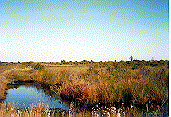 Figure 2. Photograph showing vegetation regeneration in long-abandoned peat cuttings (hand-dug) on Thorne Moore Nature reserve, on the southern part of Thorne Moors, managed by English Nature.
Figure 2. Photograph showing vegetation regeneration in long-abandoned peat cuttings (hand-dug) on Thorne Moore Nature reserve, on the southern part of Thorne Moors, managed by English Nature.
Current proposal to de-notify.
Conservation bodies view with considerable dismay the latest proposals
from English Nature -- namely to remove substantial areas on both Thorne and
Hatfield Moors from statutory protection. After 30 years of progress, this
is inevitably seen as a serious step backwards. Indeed, once this
particular step has been taken, it is unlikely that English Nature will be
in a position to re-notify the sites again in a few years' time. The areas
proposed for identification, certainly on Hatfield Moors, are those which
have the deepest peat on site and; although stripped of vegetation, these
are the areas which are the most important from an archaeological and
palaeoecological point of view.
Perhaps there are good strategic reasons for English Nature's proposals;
they might argue that in the longer-term the entirety of both sites may be
more secure as a result of this action. Unfortunately, although, English
Nature has consulted a range of bodies to seek comments on the proposal
they have provided no supporting material to demonstrate the longer-term
benefits (or even existence) of such a strategy. English Nature has
justified the proposals on the basis that:
a) the areas proposed for deletion are not significant to the hydrology of the remainder;
b) the areas proposed for deletion contain no scientific interest.
As to other aspects of the scientific interest, no evidence is presented except to state that the areas proposed for deletion are "devoid of vegetation". It is difficult to believe that English Nature, with its very clear legal remit towards fauna, flora, geology and geomorphology, has not considered the many other aspects of scientific interest associated with raised bogs in general and with these raised bogs in particular.
From a palaeoenvironmental point of view, Thorne and Hatfield Moors are arguably some of the most important Holocene palaeoenvironmental sites in Britain and as such are internationally renowned.
The Forum and PCC have also commissioned a report by Hans Joosten (1997), to examine the hydrological evidence; this is not produced here, but is being prepared for publication.
The Humberhead Peatlands.
Thorne and Hatfield Moors constitute a total area of some 3000 hectares
of raised bog peatland, located within the Humberhead Levels, which consist
of the remnants of what was once an extensive complex of raised mires and
other wetlands. The Moors are the two largest surviving examples of lowland
raised mire peatland in England. The Levels are a meeting place of northern
and southern types of vegetation (Heaver and Eversham 1991), so a variety
of species which normally do not mix can be found here. They are also
different in character to other lowland raised mires elsewhere in Britain,
and one of the main reasons for the sites' importance.
They are also notable for having developed in an area of low precipitation (c.600 mm/yr), warm climate and high evapotranspiration potential (510 mm/yr). Indeed, they receive the minimum amount of precipitation considered necessary for ombrotrophic peat growth (Money 1995). For these reasons, the Moors have been recognised as particularly sensitive sites for palaeoenvironmental research (Smith 1985; Whitehouse et al. 1997), compared with many other sites from the more oceanic west of Britain (cf. Barber 1981; 1985). They also provide a wealth of information about the biogeography of numerous species (Eversham et al. 1995), making the palaeoenvironmental importance of these sites unparalleled.
The peat on the Moors has built up because in the past the permanently high water table and acidic conditions inhibited biological decomposition. The peat archive provides a three dimensional record of the plants and animals that once lived on the peat surface and the way in which the mire has developed in response to environmental change over time. Variations in the plant and animal components of the peat archive reflect changing environmental conditions, such as mire surface wetness and nutrient status. Since the main water input and several of the principle outputs of the bog water balance are influenced by climate (e.g. temperature, precipitation and humidity) the peat archive also preserves a proxy record of climate change. Material from beyond the margins of the bog may also be incorporated into the peat archive as a result of having been aerially transported or carried by water onto the peat surface. Thus, the peat archive contains a record of changes in the wider landscape beyond the peatland. It may also contain important archaeological information; Turner and Briggs (1986: 145) argue that this area is the most important in England for bog burials.
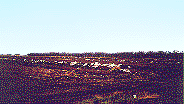 Figure 3.
Figure 3.Photograph showing milling fields on Thorne Moors, with underlying pro-glacial Lake Humber clay silts shown piled up adjacent to the milling drains.
Thorne and Hatfield Moors: different sites.
The palaeoenvironmental record indicates that Thorne and Hatfield Moors
developed from very different starting points, in different ways and at
different rates. This led to the individual characters which are still
evident today. In addition, the different substrates beneath the sites has
influenced their character.
Thorne Moors is largely underlain by the pro-glacial Lake Humber clay silts. Hatfield Moors is underlain by Devensian glacio-fluvial sands and gravels and an aeolian late Glacial/early Holocene sand dune system (Gaunt, 1994), a unique situation in Britain. A Devensian glacial moraine is also contained in the middle of the bog. As a result, Hatfield Moors has a much stronger sandy heath component within both its modern and fossil flora and fauna compared with Thorne Moors. Hatfield Moors has traditionally been viewed as an essentially more degraded version of Thorne Moors and the better survival of Thorne Moors seems to have been at the detriment of Hatfield Moors.
Palaeoenvironmental research on Thorne and Hatfield Moors.
There has been a long history of research into the peats of Thorne and, to a
lesser extent, Hatfield Moors. Work has included the study of plant pollen
and macroscopic remains, tree ring sequences and fossil insects (Erdtman
1928; Pigott 1956; Smith 1958; Turner 1962; Buckland 1979; Smith 1985;
Whitehouse 1993; 1997; Roper 1993; 1996; Whitehouse et al. 1997; Boswijk
forthcoming). The most significant palaeoenvironmental research results are
summarised below:
Peat began to develop on both Moors about 4500 years ago.
Radiocarbon dates from the base of peat on Thorne and Hatfield Moors
indicate that peat began to develop about 4500 years ago. The handful of
basal radiocarbon dates from Thorne Moors indicate that peat developed first
in the northern part of the present Moors and spread south-eastwards (Smith
1985). This is further supported by pine dendrochronological evidence which
indicates the progressive south-eastern displacement of pine forest growing
on the ombrotrophic mire margin (Boswijk forthcoming).
Parts of the Moors retain a peat archive extending into the medieval period.
Although peat continued to accumulate up until at least the sixteenth century, peat cutting and drainage have destroyed the peat archive spanning the
historic period over much of both Moors. Nonetheless, in some areas medieval
peat is preserved and remains a rare palaeoenvironmental record: as much of
this part of the archive has been destroyed over lowland Britain, there
are no other comparable sites in eastern England.
Thorne Moors developed in a markedly different way from Hatfield Moors.
It is thought that prior to paludification and peat growth, relatively
undisturbed mixed deciduous forest covered Thorne Moors. Mire developed by
succession from minerotrophic fen, via mesotrophic poor fen to ombrotrophic
and oligotrophic bog (Smith 1985). In contrast, prior to peat growth on
Hatfield Moors, heath and pine forest covered much of the landsurface and
mesotrophic and ombrotrophic peats appear to have developed over the original
landsurface (Smith 1985). However, the most recent fossil insect work suggests
that locally there may have been an initial fen phase on the southern side
of Hatfield Moors (Whitehouse unpubl.).
The pollen record from different sites within each Moor shows marked
differences and there are significant differences between pollen records
from the two Moors.
Pollen records from the peats provide a detailed, high resolution record of
vegetation changes in the region during the last 4,500 years. Smith (1985)
had great difficulty in providing summary "regional pollen assemblage zones"
for the Humberhead Levels based on his results from the two Moors because
the pollen signals from individual palaeoecological sites were often
distinctly different, reflecting the varying origins of the two peatlands.
The peat archives record the complex succession of peat-building Sphagnum
mosses which vary between sample sites.
Peat macrofossil analysis from both Moors indicates a complex sequence of
Sphagnum moss successions. There is a marked difference in the Sphagnum moss
succession on different parts of Thorne and Hatfield Moors. These differences
emphasise the complexity of mire response to environmental conditions and the
inadequacy of limited reference points.
The peats contain fossils of numerous beetles now extinct in Britain and
highlight the continental (Baltic) character of the two bogs.
The fossil insect record preserved within the peats of Thorne and Hatfield
Moors contains at least 16 species of beetle that have become extinct in
Britain since the later prehistoric period and ongoing research is adding to
the list (Buckland and Dinnin 1993; Whitehouse 1997; unpubl.; Whitehouse et
al. 1997). The majority of the extinctions are associated with ancient
woodland habitats and especially native pine forests. Many of the rare and
nationally extinct beetle species found in the peats exhibit a continental
distribution and are not found in more oceanic western parts of Britain and
NW Europe.
The two Moors are apparently very sensitive to changes in climate.
Five recurrence horizons, reflecting shifts from drier to wetter bog surface
conditions, can be traced in peats on the two Moors (Smith, 1985). These are
attributed to changes to a cooler and wetter climate during the later
prehistoric and Anglo-Saxon periods, perhaps enhanced by phases of sea-level
rise. However, mires respond to changes in the water balance in a complex
manner and changes in bog surface wetness are not synchronous across the
individual peatlands. Recent work on modern bogs suggests that bog hydrology
is even more complex than previously suspected (cf. Glaser et al. 1997): the
climatic signal preserved within peats is clouded by that arising from
processes within the bog. Thus, lateral continuity of the peat stratigraphy
across all parts of a bog is required to identify a climatic signal from the
record.
 Figure 4.
Figure 4.Large bog oak found on Thorne Moors, which has been sampled for dendrochronological analysis.
The tree-ring chronologies from fossil trees on the two Moors are nationally
important.
The tree-ring chronologies from buried pines and oaks not only provide
information about the timing of forest development on the two Moors but are
also nationally important in terms of establishing dating chronologies. The
sequences from Thorne and Hatfield Moors strengthen and extend regional and
national chronologies which are used for dating archaeological timbers (and
therefore evidence for past human activity) elsewhere in the UK. The
successful correlation of the pine and oak chronologies on Thorne and
Hatfield Moors, acheived for the first time in England, potentially extends
the application of dendrochronological dating (Boswijk forthcoming).
The moors have a proven archaeological record but current land use reduces
the archaeological visibility.
A recent survey identified the Humberhead Levels as the richest area for bog
bodies in Britain (Turner and Briggs 1986; Turner and Scaife 1995). Five
excellently preserved bodies have come from Hatfield Chase and Thorne Waste,
of which the two Moors once formed a major part. Antiquarian sources refer
to a trackway traversing Hatfield Moors linking Lindholme to adjacent drier
ground. During the 1970's a Bronze Age wooden trackway was discovered on the
western side of Thorne Moors (Buckland 1979). Only a short section was
excavated but a detailed palaeoenvironmental study was carried out. A series
of mainly prehistoric finds and lithic scatters have been found in areas
that were formerly covered by peat bog but have been reclaimed from Thorne
and Hatfield Moors during the last three centuries (e.g. Nun Moors; Van de
Noort and Fenwick 1997). It is likely that further remains occur in and
beneath the peat on the surviving peatlands; the current surface milling
technique adopted severely impedes the recognition of organic archaeological
remains exposed on the surface (Dinnin 1994; 1997).
The palaeoenvironmental archive provides important information for nature
conservation.
There is a general lack of scientific information about how peatlands work
at the ecosystem level, as opposed to the habitat/species level.
Palaeoecology provides this overview. The palaeoenvironmental record provides
the only opportunity to examine natural processes on a timescale longer
than is possible in real-time studies. It also enables an assessment of the
long-term impact of past human activities on the bogs (e.g. renewal of peat
accumulation in abandoned peat workings, Smart et al. 1986). Since it is
English Nature's intention to attempt restoration of cut-over areas (N.B.
you cannot recreate the archive once it has been destroyed!), the peat
record is the only source of information recording the processes which led
to the development of these bogs.
Retaining upstanding blocks of peat as representative palaeoenvironmental
archives is unviable.
Dept of the Environment (DoE) (1994: 47) guidelines suggest that
"access to the peat archive does not necessarily require the presevation of entire bog sequences...archival requirements might be met by retention of substantial uncut blocks within peat cutting complexes."
This is difficult to justify on two grounds. Firstly, the results of research from Thorne and Hatfield Moors outlined above, together with that at other mire sites in the UK and Europe, indicate that there is great spatial and temporal variation in mire response to environmental stimuli. This means that there is in effect no such thing as a representative section. Secondly, the retention of upstanding reference blocks of uncut peat is practically difficult on hydrological grounds. The maintenance of the mire system as a whole is the optimal way to preserve the peat archive in perpetuity.
Stockpile of Scots pine on edge of milling field, Thorne Moors.
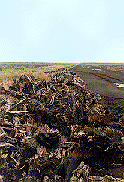 Figure 5.
Figure 5.Consequences of the loss of SSSI on parts of Thorne and Hatfield Moors:
the palaeoenvironmental case.
Currently, there is no secure legislative protection which deals specifically
with the peat archive in Britain, although SSSI status does provide some
measure of protection, particularly when the guidelines are interpreted in a
considered, scientific manner. The joint statement of intent for the
conservation of the natural and archaeological environment issued by English
Heritage and English Nature recognises the coincidence of interests and the
need for partnership on management of land with SSSI protection. Removal of
SSSI status means that English Nature are no longer obliged to consult
English Heritage over proposed land management changes. The loss of the
SSSI status on parts of Thorne and Hatfield Moors would effectively remove
any protection of the palaeoecological archive.
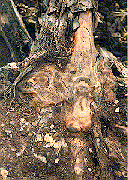 Figure 6.
Figure 6.Detail of charred Scots pine, Thorne Moors.
Guidelines for the Selection of SSSI's.
In England, English Nature, the Government's nature conservation agency, is
the statutory body charged with responsibility towards the conservation of
sites of biological and geological/geomorphological importance.
Selection of Biological SSSI's.
The Guidelines for the selection of Biological SSSI's recognise the
importance of the palaeoecological record. The supplement to the guidelines
specifically for bogs (point 1.6) states that:
"Ombrotrophic mires have great value to Holocene ecological and archaeological studies".
Point 2.6 states that:
"... the bog archive...has become increasingly used in international studies of climate change. The conservation of this resource is particularly important in the light of current concern about global warming."
The importance of the palaeoecological archive is clearly acknowledged within the guidelines as part of the scientific interest of a raised mire; one could therefore argue that this makes the importance of the palaeoecological archive part of the selection criteria of SSSI's.
With regard to Hatfield Moors, English Nature proposes to denotify areas of unvegetated peat as it "has no special interest", even though English Nature's own guidelines categorically state that peat deposits have great value to Holocene ecological and archaeological studies. There is ample evidence presented here and in the cited publications of the importance of the palaeoecological archive preserved at these sites, yet English Nature have failed to acknowledge this evidence. To state that there is "no scientific interest" is wrong: the archive forms part of the scientific interest of a site and as such adds to or enhances the scientific importance of the site. By failing to notify the bare areas of peat at the site English Nature is effectively throwing away part of its scientific interest. Point 4.2 of the Guidelines state that:
"... even if the damage is considered to be severe... [m]any sites retain great intrinsic biological and scientific value".
Whilst the botanical importance of areas devoid of vegetation may be questioned, their scientific interest cannot be questioned, since their palaeoenvironmental significance remains. The fact that the peats of the Moors, including areas proposed for denotification, have been the subject of at least five palaeoenvironmental doctoral research projects, of which two are ongoing, demonstrates that they are of scientific importance.
Geological/Geomorphological SSSI's & RIGS.
In England, English Nature is charged with responsibility towards the
conservation of sites of natural and geological/geomorphological importance.
Since the peat archive is part of the geological record, albeit amongst the
most recent sediments, it should therefore fall within the remit of English
Nature.
English Nature recently launched its RIGS scheme (Regionally Important Geological/Geomorphological Sites) which includes a set of guidelines for assessing and evaluating sites (Harley 1994). Applying the RIGS evaluation criteria to the proposed areas for denotification indicates that these areas should qualify within this category. The site demonstrates important sedimentary features, such as recurrence surfaces, a buried prehistoric forest, a Late Glacial dune system and terminal Devensian moraine (Hatfield Moors), mire hummock and pool features. The site is also important in terms of stratigraphic correlation; this is demonstrated by the radiocarbon dated chronology for regional vegetation and climatic changes which have been used to correlate vegetational changes throughout the Humberhead Levels. Recurrence surfaces within the peat of Thorne and Hatfield Moors have been correlated with continental peatlands (Smith 1985). The sites are unique in terms of correlations between pine and oak chronologies in mainland Britain and Europe (Boswijk forthcoming; Chambers et al. 1997). The sites are especially important for fossil insect species and assemblages, preserving the richest primary forest beetle assemblage recorded from Britain (Whitehouse 1997), as discussed above. The site is therefore important palaeoecologically, preserving an important record of mire development, regional landscape change and Holocene climate, in a climatically marginal part of Britain, as well as being arguably the most important sites in terms of Holocene fossil insect palaeoecology in the UK.
Thus, English Nature's own criteria highlight the geological and geomorphological importance of the sites.
English Heritage's position.
English Heritage is the government's statutory advisor on archaeology and
the historic environment; it advises the Secretary of State for Culture on
sites recommended for Scheduling. Scheduling applies to culturally formed
structures or cultural deposits formed/created as the result of human
activities. Unfortunately, English Heritage is unable to act upon those
sites where the effects of cultural activity are incorporated or embedded
within largely natural deposits, such as the palaeoecological archive, even
when they have considerable archaeological relevance and interest. Even
where such a resource is identified, the tendency is towards the
'scheduling' of the monument to its defined boundaries. This inadequate for
peatlands and other wetlands that are inevitably affected by more distant
activities occurring on adjacent land (e.g. peat cutting and drainage [Coles
1995]). The heritage value of indirect palaeoenvironmental evidence for
human activity and an unproven (i.e. potentially undisturbed and well
preserved) archaeological resource is not accommodated within the present
legislation. It is only through disturbance and irreversible damage that
most wetland archaeological sites come to light and become available for
statutory protection. In many cases, the archaeological resource may be so
damaged that it no longer merits Scheduling. There therefore exists a
paradox: only when the archaeological resource is harmed or eroded is it
revealed, by which time it is too late to protect any remaining archaeology.
The inadequacy of this approach in such areas has been highlighted in a
recent report commissioned by English Heritage and an 'area of interest'
approach is recommended(Coles 1995).
 Figure 7.
Figure 7.Painting of Temnochila coerulea, Westw., fossil insect "nationally extinct", known to occur only in deposits from Thorne Moors. Painting by Peter Skidmore.
Statement of intent for the conservation of the natural and archaeological
environment.
This joint statement of intent issued by English Nature and English Heritage
recognises the coincidence of interests between the two organisations and
the need for partnership. The statement establishes procedures to ensure
that the respective interests of the two organisations are taken into
account in the management of land. Removal of SSSI status will mean that
English Nature are no longer obliged to consult English Heritage over
proposed land management changes.
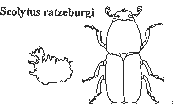 Figure 8.
Figure 8.Modern distribution of Scolytus ratzeburgi Jan. and
Tecmnochila coerulea Westw. with 17 degrees July mean
isotherm. These species were recovered as fossils within
the same context, in deposits of c. 4,000-3,000 B.P. on Thorne
Moors; Scolytus ratzeburgi has also been found in fossil deposits
on Hadfield Moors. The distribution illustrates some of the
current problems in the interpretation of such data. For
example, do these distributions reflect variation in oceanicity versus continentality
in the late Holocene climate? Note: actual species distribution
is much more discontinuous. Question marks indicate a lack of information,
rather than known absence of species.
This drawing has been published previously in Whitehouse et al., 1997.
Drawing: Philip I. Buckland.
Humberhead Levels Natural Area.
The Natural Areas Profile for The Humberhead Levels Natural Area recently
published by English Nature (1994) states that an objective is to:
"Promote, secure and enhance the geological, palaeontological and archaeological archive found in the Levels."
Denotification of SSSI status on peatlands that are currently part of the Humberhead Peatlands SSSIs would appear to directly contradict not only the actual title of the SSSI (i.e. peatlands) but also the expressed objectives of the Natural Area Profile and weaken the status of the Holocene archive in general. The importance of the palaeoecological archive has been recognised by EN in other contexts where important palynological sites have been designated (e.g. Tadcaster Mere and Roos Bog).
Recent developments in Scotland.
Despite the reluctance within England, particularly by English Nature, to
designate SSSI sites on palaeoecological grounds, there has been more recent
recognition that the palaeoecological issue is not being fully addressed
within the SSSI guidelines. The Second Report of the independent Advisory
Committee to Scottish Natural Heritage (the Government's statutory body for
nature conservation in Scotland) (1997) suggests that the qualifying
features set out in the 'Guidelines for the Selection of Biological SSSI's'
fail to convey fully a site's interest. They go on to say (point 16) that:
"Members of the Committee consider that SSSI notifications should go beyond the straightforward reconciliation of site features with the published site selection criteria. For example, there are many reasons for conserving mires � and perhaps more fundamentally, palaeoecological � with climate change a topical issue, examinations of layered accumulations of pollen and human artefacts might provide evidence of the responses of plant assemblages to changes of weather in the past�The Committee � considers that there would be merit in the JNCC reviewing and possibly amending site selection criteria."(authors' bold).
The Committee's function is to interpret the guidelines and advise on the scientific merits of site selection. The Advisory Committee is thus an objective, expert arbiter about the interpretation of the Guidelines, at least in Scotland. The significance of this recommendation is far reaching and one which English Nature at least appears to have failed to appreciate, given that they provide an objective, expert opinion.
CONCLUSIONS AND RECOMMENDATIONS.
The front page of The Guardian (24th November, 1997) leads with the headline:
"The guardians of nature: "secretive, defensive and turning a blind eye to destruction�.",
as a result of a damming report compiled by the Worldwide Fund for Nature: surely it is time for all those involved in the conservation of our natural and cultural heritage to make a stand.
POST SCRIPT.
On the 2nd December 1997, the following Press Release was issued by English
Nature:
"Speaking today after a meeting of English Nature's Council, its Chairman, the Earl of Cranbrook, said that, having considered all the relevant scientific evidence, the SSSI boundaries of Thorne and Hatfield Moors would not be amended".
This was due to the fact that Council had:
"received an amplified report from the Institute of Hydrology and other evidence that now clarifies that the areas of uncertainty are greater than had been indicated earlier. In the light of the full report, Council has decided not to proceed with the proposed denotifications. The effect in both cases is to leave the SSSI boundary as it is".
This report forms part of that "other evidence". However, lest this decision lead to complacency, it will not stop peat mining on Thorne and Hatfield moors - SSSI denotification does not affect existing planning permissions. The destruction of peatland sites such as these is driven by the market for peat - consumers must choose peat alternatives or accept the ultimate responsibility for the destruction of these sites.
ACKNOWLEDGEMENTS.
Particular thanks to Gretel Boswijk at the University of Sheffield
Dendrochronology Laboratory for access to unpublished information and
comments upon various drafts of this report; also to Jennifer Hillam, Ian
Tyres and Kathy Groves, of the University of Sheffield Dendrochronology
Laboratory. Paul Buckland, University of Sheffield, for comments on the
draft of the paper. In addition, the following people provided information:
Morag Milne (SNH); Richard Morris (CBA); Rob Stoneman (SWT).
REFERENCES
Barber, K.E. 1985. Peat stratigraphy and climatic change: some speculations.
In M.J. Tooley and S.N. Twigger Eds. The Climatic Scene. London, Allen &
Unwin. pp175-185
Barber, K.E. 1981. Peat stratigraphy and climate change - a palaeoecological test of the theory of cyclic bog regeneration. Rotterdam, Balkema..
Boswijk, B. forthcoming. Palaeoforest reconstructions and the development of raised mire at Thorne Moors in the Humberhead Levels, south Yorkshire and Lincolnshire. University of Sheffield, PhD thesis.
Buckland, P.C. 1979. Thorne Moors: a palaeoecological study of a Bronze Age site; a contribution to the history of the British insect fauna. Dept. of Geography, University of Birmingham, Occasional Publication Number 8.
Buckland, P.C. and Dinnin, M.H. 1993. Holocene woodlands, the fossil insect evidence. In Eds. K.J. Kirby and C.M. Drake. Dead wood matters: the ecology and conservation of saproxylic invertebrates in Britain. English Nature, No 7: 6-20.
Chambers, F.M.; Lageard, G.A.; Boswijk, G.; Thomas, P.A.; Edwards, K.J. and Hillam, J. 1997. Dating prehistoric bog-fires in northern England to calendar years by long-distance cross-matching of pine chronologies. Journal of Quaternary Science 12(3): 253-256.
Coles, B. 1995. Wetland management, a survey for English Heritage. Exeter, WARP Occasional Paper 9.
Department of Environment, 1994. Report of the working group on peat extraction and related matters. London, HMSO.
Dinnin, M.H. 1997. Introduction to the palaeoenvironmental survey. In Van de Noort, R. and Ellis, S. Eds. Wetland Heritage of the Humberhead Levels. Hull, University of Hull. pp31-45.
Dinnin, M.H. 1994. An archaeological and palaeoecological investigation of Thorne Moors, with particular reference to the buried prehistoric forest. Sheffield: ARCUS Report 148.
English Nature, 1997. The Humberhead Natural Area. Natural Area Profile.
Erdtman, G. 1928. Studies in the post-arctic history of the forests of north-western Europe. I. Investigations in the British Isles. Geol. F�ren. Stockh. F�rh. 50. pp123.
Eversham, B.C.; Buckland, P.C. and Dinnin, M.H. 1995. Lowland raised mires: conservation, palaeoecology and archaeology in the Humberhead Levels In: M. Cox; V.Straker and D. Taylor Eds. Wetlands: archaeology and nature conservation. London, HMSO. pp75-85.
Gaunt, 1994. Geology of the county around Goole, Doncaster, and the Isle of Axholme. British Geological Survey, London, HMSO.
Glaser, P.H.; Siegel, D.I.; Romanowicz, E.A. and Ping Shen, Y. 1997. Regional linkages between raised bogs and the climate groundwater and landscape of north-western Minnesota. Journal of Ecology 85: 3-16.
Harley, M. 1994. The RIGS (Regionally Important Geological/Geomorphological Sites) challenge involving local volunteers in conserving England's Geological Heritage. In O'Halloran, D.; Green, C.; Harley, M.; Stanley, M. and Knill Eds. Geological and landscape conservation. Geological Society, London.
Heaver, D. and Eversham, B. 1991. Thorne and Hatfield Moors Invertebrate Survey Report. Thorne: Thorne and Hatfield Moors Conservation Forum (unpublished).
Joosten, J.H.J. 1997. Moor or less: a critical evaluation of the hydrological basis for denotifying parts of Thorne and Hatfield Moors as SSSIs. Unpublished Report to the Thorne and Hatfield Moors Conservation Forum and the PCC.
JNCC (Joint Nature Conservation Committee), 1994. Guidelines for the selection of Biological SSSIs: bogs. JNCC, printed by Stephen Austin and Sons Ltd.
Money, R.P. 1995. Re-establishment of a Sphagnum-dominated flora on cut-over lowland raised bogs; regeneration with special reference to palaeoecological studies. In B.D. Wheeler; S.C. Shaw; W.J. Fojt; and R.A. Robertson Eds. Restoration of Temperate Wetlands. Chichester, J.Wiley and Sons. pp405-422.
Pigott, C.D. 1956. Vegetation. In D.L. Linton, Ed. Sheffield and its region. British Association for the advancement of Science.
Roper, T. 1996. Fossil insect evidence for the development of raised mire at Thorne Moors, near Doncaster. Biodiversity and Conservation 5: 503-521.
Roper, T.1993. A "waste" of resources: the origins, growth and decline of Thorne Moors; a palaeoentomological study. University of Sheffield, Unpubl. MSc dissertation.
Smart, P.J., Wheeler, B. D. & Willis, A.J. 1986. Plants and peat cuttings: historical ecology of a much exploited peatland - Thorne Waste, Yorkshire, UK. New Phytologist 104: 731-748.
Smith, A.G. 1958. Post-glacial deposits in south Yorkshire and north Lincolnshire New Phytologist 57: 19-49.
Smith, B.M. 1985. A palaeoecological study of raised mires in the Humberhead Levels. University of Wales, Unpubl. PhD. Thesis.
Turner, J. 1962. The Tilia decline: an anthropogenic interpretation. New Phytologist 61: 328-341.
Turner, R. C. and Briggs, C.S. 1986. The Bog Burials of Britain and Ireland. In I.M. Stead; J.B. Bourke; and D. Brothwell. Eds. Lindow Man; the Body in the Bog. London, British Museum Publications. pp144-161.Turner, R.C. and Scaife, R.G. Eds. 1995. Bog bodies; new discoveries and new perspectives. London, British Museum Press.
Van de Noort, R. and Fenwick, H. 1997. Introduction to the archaeological survey. In R. Van de Noort and S. Ellis. Eds. Wetland Heritage of the Humberhead Levels. Hull, University of Hull, English Heritage. pp219-228.
Whitehouse, N.J. 1997. Silent Witnesses: an Urwald Forest Insect Assemblage from Thorne Moors. Thorne and Hatfield Moors papers Vol.4: 19-54.
Whitehouse, N.J. 1993. A mid - Holocene forested site from Thorne Moors: the fossil insect evidence. University of Sheffield, (Archaeology & Prehistory), unpubl. MSc. thesis.
Whitehouse, N.J.; Boswijk, G. and Buckland, P.C. 1997. Peatlands, past, present and future; some comments from the fossil record. In L. Parkyn; R. Stoneman; and H.A.P. Ingram. Eds. Conserving Peatlands. CAB International: 54-64.
About the Authors
Dr. Mark Dinnin is Lecturer in Physical Geography and Environmental Sciences, University of Sussex. Research interests include palaeoecology and landscape change during the late Holocene, from a fossil insect perspective. Other interests include wetlands and more specifically wetland development in the Humber basin during the Holocene and the conservation of natural and heritage resources. For another profile, click here.
Nicki Whitehouse is a fourth year PhD student at the Dept. of Archaeology and Prehistory, University of Sheffield. Her research interests focus on Holocene wetland landscape development and change, from a palaeoecological perspective, using a palaeoentomological approach. Her research currently concentrates on the Humberhead Levels peatlands and floodplains. Other interests include examining natural and cultural changes which have affected Holocene woodlands and their associated invertebrate faunas, as well as conservation issues surrounding wetlands. Nicki is secretary and co-chair of the Thorne and Hatfield Moors Conservation Forum and a member of the Steering Committee of the Mires Research Group, affiliated to the British Ecological Society.
Richard Lindsay graduated from the University of East Anglia in 1975, and worked for 15 years as the national peatland specialist for the Nature Conservancy Council, then for 4 years as peatland specialist to Scottish Natural Heritage. Since leaving there in 1996 he has circumnavigated the globe, working with peatland conservation issues, and is now Head of Wildlife Conservation at the University of East London. For 10 years he has been Chairman of the International Mire Conservation Group, which is the network of peatland specialist around the world who advise their own governments on peatland conservation issues. He is particularly interested in survey and classification of mire systems for conservation purposes.
© Mark Dinnin, Nicki Whitehouse and Richard Lindsay 1997
 Go on, e-mail assemblage today!
Go on, e-mail assemblage today!

| 
| 
|

| 
| 
|

| 
| 
|

| 
| 
|
© assemblage 1997